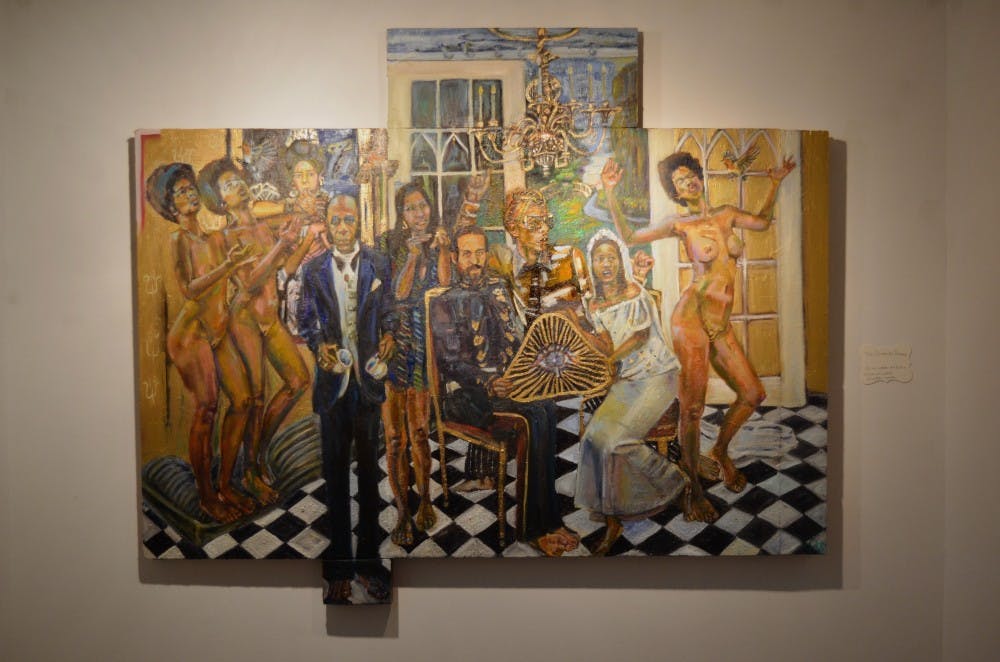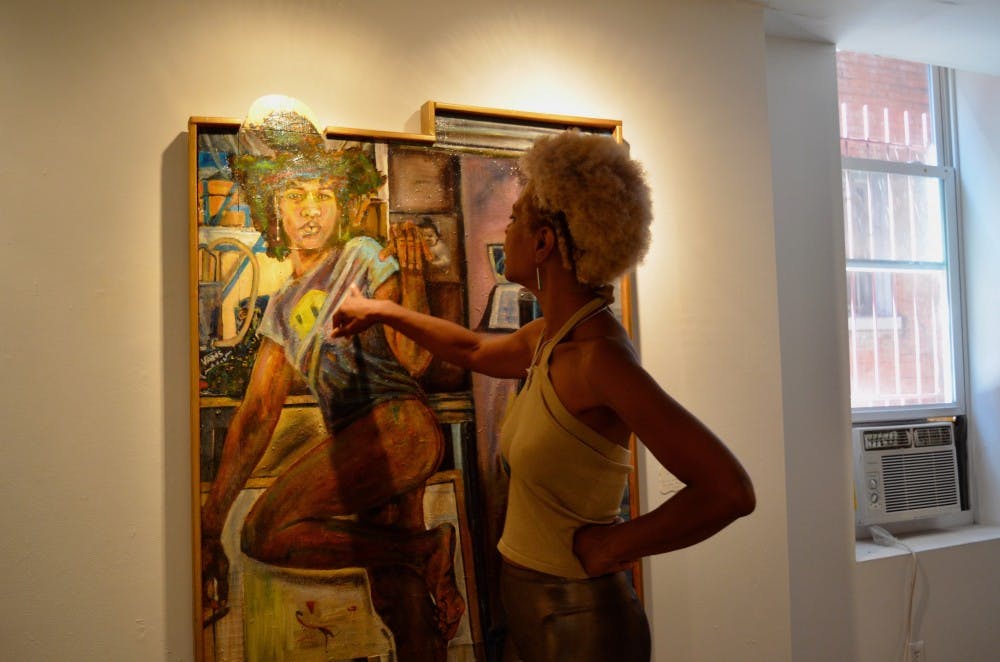“Presenting the Damn Thing,” a solo exhibition of a collection of paintings, seeks to provoke a distinctly American dialogue. The creator of the exhibit and its artwork, artist Inga Kimberly Brown, brings a unique perspective to the conversation with how she brings her mixed media paintings to life.
Brown meets me outside of her exhibit, which ended on Sep. 30, on a sunny Saturday, smiling widely at me while fishing for her keys in a bag that clunks around. Her foster child sleeps soundly as he's strapped to her, not stirring as she withdraws her keys and opens the door to her space on 40th and Chestnut Street, chatting about the difficulty of finding parking here. We step inside a narrow hallway and enter her gallery, which contains seven of her paintings in one small room. She makes small talk as we settle in, largely about our common roots of being from Philadelphia. She's from West Mount Airy and the daughter of racially mixed parents.

Brown’s work incorporates some of this personal history. She uses wood in her art because it speaks to her. “Wood just seems a little bit more raw, a little bit more familiar. My father is a carpenter. Most of my family works with their hands.” Her exploration of her own racial heritage and family history is evident throughout her paintings, though sometimes it's not planned for.
“I don’t like to plan things out," she says, explaining one of her pieces entitled The Grande Damn. "[The painting] is so special because [it] has things that were never meant to be there,” she continues serenely, gesturing towards the painting as she explains. Brown approaches her paintings with a general idea of what she’s going to paint, but doesn’t usually know the specifics. In The Grande Damn, there are blurred faces in the windows looking in that she did not anticipate adding, and a woman in white whose face Brown has never seen. The woman in white wears an intense expression of shock and pain, her mouth partially open and her raised eyebrows reacting to an unseen menace in the distance.

The Grande Damn is also noteworthy for the layers it spans in both content and form. Three naked women sing a wedding song alongside the woman in white, and a recording plays beneath the painting to convey a mournful song. Small blocks have been added to the canvas, to extend the feet of the butler and to create a higher ceiling. David Bowie resides in the background, adding a temporal dimension to a home that seems to be from a distant past. It’s incredibly thoughtful, though Brown insists that all of it mostly just “happens.”
While Brown is a whimsical and spiritual person, there are still certain motifs that pop up in most of the paintings. The most notable one is nudity. "Your nudity is your truth," she nods. "There's always been a sexual force behind mankind," she elaborates, and she points to Marie, Daughter of the Revolution, which portrays a semi–nude slave woman; she also directs me towards "Captain Trick," a painting of a nude white man resembling a slave master with a bag over his head. This open display of sexuality in her artwork is part of a discussion she says we've been "too polite" to have—one about the role that sexual dynamics played in slavery.

Much of Brown’s art is not supposed to "mean" anything. However, she draws on meaningful inspiration for her work. The March represents the death of her aunt. Boom Boom at the Bijou expresses her vision of West Philadelphia, which exuded a heavy energy of imprisonment and oppression Brown noticed when she first moved there. She doesn’t impose her vision on the viewers, however. Her paintings will be interpreted differently by every viewer, she explains, and each person will take home disparate messages from her work.
Ideas of American heritage are interspersed throughout the paintings. Moccasins are strapped on to the canvas of Boom Boom at the Bijou, acting as a tribute to Native Americans. Painted newspaper clippings of slave auctions decorate the background of Marie, Daughter of the Revolution. It’s all part of the American saga, a story rooted in race. All in all, Brown's collage of materials, stories, and temporal dimensions is a powerful contemplation of what it means to have an American identity.

